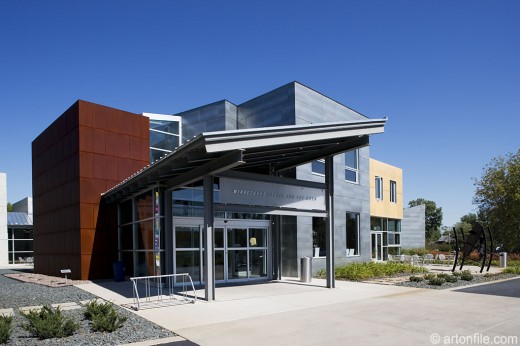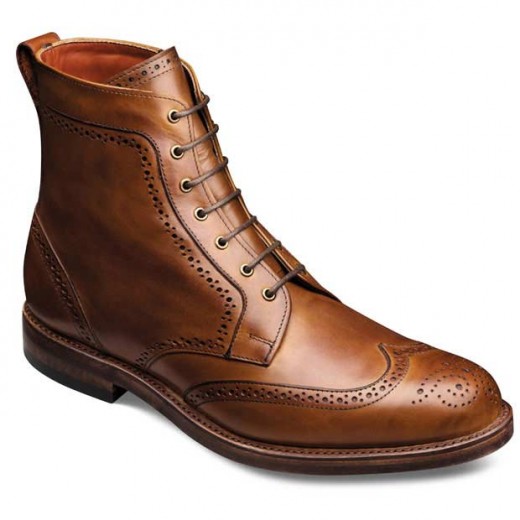 Minnetonka Center for the Arts-Image from artonfile.com
Minnetonka Center for the Arts-Image from artonfile.com
If you had Frank Gehry as your architectural mentor, your buildings are bound to be noticed in Minnesota. Local architect and Gehry protégé, Jim Dayton, is a master at combining unique building materials to create visually stunning contemporary architecture and interiors. Recently, I had the chance to sit down with Dayton in his NE Minneapolis office and learn more about his background and design process. Dayton heads up a team of 11 at James Dayton Design. Dayton and his team are responsible for designing a number of acclaimed buildings that influence the Twin Cities’ architectural landscape. Such buildings include the MacPhail Center for the Music‘s Minneapolis location, the Highpoint Center for Printmaking, the Blake School‘s Wayzata campus and the Minnetonka Center for the Arts. Please read on after the jump for my full interview with Jim Dayton.
 Image courtesy of James Dayton Design
Image courtesy of James Dayton Design
Before Dayton became an architect, he grew up as part of the Dayton department store family and therefore, has always been interested in good design. He first remembers becoming interested in architecture and design at the age of 7 and always knew that he would eventually end up in the field. By the time he reached high school age, Dayton was spending his summers interning at architecture firms.
Aside from architecture, Dayton also grew up with a love for the arts. He originally wanted to be an artist, “Early on, there was a discipline and rigor that I grew up around which wouldn’t allow to be an artist. My father was task-oriented and as a young kid, it is hard to imagine escaping all of that.” The logical choice was to choose design as a business, “I didn’t want to be a banker where you are working a spreadsheets. Architecture is a perfect combination of numbers and trying to be artistic with what you do. It’s business oriented, so it’s a nice balance.” Jim still paints, using gouache as his main medium. In his early architecture days, Dayton studied and worked in the “Santa Monica School” of architecture alongside Frank Gehry. Much of what he learned from his days working with Gehry translate into his current architectural style.
At 16 years, James Dayton Design is a relatively young architecture firm, but already has experience in residential, commercial and civic design. While Dayton enjoys residential design, he is most excited when designing public spaces: “Public discourse is what I enjoy about public spaces. Making a gesture to the city or rural community. Making something for the public that is about community and about dialogue and about urban conditions. Houses tend to be more about personal.”
In many of his buildings, Dayton uses nontraditional building materials. “I’ve taken a ‘why not’ mentality about being able to use materials,” Dayton states, “We use some of the humble materials like corrugated metal that most people take for granted.” Many of the materials Dayton uses are selected for their inexpensiveness and ease of use. “Most people put a concrete floor down and decide to carpet it or put a rug down, but what if we left it as is? You have to pay for it anyhow, why don’t you put a coat of wax down and call it a day?” By using various types of raw and unconventional materials, Dayton’s buildings leave a stunning, visual impact.
 MacPhail Center for Music, Photo Courtesy of James Dayton Design
MacPhail Center for Music, Photo Courtesy of James Dayton Design
When Dayton begins a public-facing project, he takes the context of the neighborhood surroundings into consideration and works to create a new building which will compliment the neighborhood, but won’t completely blend in. Dayton discusses his process of building the MacPhail Center for Music in Downtown:
“I think context is really important and I think one of the misconceptions about contemporary architecture. And there are some (buildings) which are a-contextual and I really like that as well, like Macphail. There, we tried to take some clues from the neighborhood and render them in a new way. Our take on it was: well, lets do brick, but make it a unique form. So the base of the entire building is brick, just like the neighborhood. Now, it’s black brick instead of red. There are 100 different colors of brick in the neighborhood, but black is a fairly unusual one. As you walk past as a pedestrian, you know the scale of the brick and you are familiar with the texture, and the shape and it feels like you belong to the neighborhood. The corten, or the rusted steel box of the hall, is a nod to the mills and the infrastructure that’s there, but without being derivative. It doesn’t look like a mill necessarily. We should build new, but respect the old and respect the context and try to make a gesture that is finds its way between the two of them.”
 Dalton boot by Jim Dayton. Photo courtesy of Allen Edmonds
Dalton boot by Jim Dayton. Photo courtesy of Allen Edmonds
Dayton’s love of design extends beyond architecture. Growing up in a retail family, it is no surprise that Dayton has an eye for fashion. He is a big fan of his brother’s store, Twill, as well as Martin Patrick 3. His love of fashion and design recently came together and permitted him to add “Shoe Designer” to his list of accomplishments. Dayton works with shoe retailer, Allen Edmonds, to design their store prototypes. Edmonds was so pleased with Dayton’s architectural work that they asked him to design a shoe for their collection. The result is the gorgeous Dalton boot. (The name is a nod to his family, who owned B.Dalton bookstores). The boot was so popular that Allen Edmonds now carries it in a limited edition, cordovan leather. Dayton recalls his experience: “I presented a dozen different ideas to them. A loafer, a dress shoe, amongst a bunch of other things. And then I have a pair of English wingtip boots that my wife gave me years ago that I wear a lot, and I love them! They are unique. People comment on these all the time, and one of the guys in the office said, ‘Well, you’ve got to do an English boot because it gets so many comments.’ So ironically, that was the one they went with.” Dayton proudly wears his boot with jeans rolled up a tad to show off the shoe’s beautiful leather.
Even though Dayton has many buildings he admires in Minnesota, his favorite public building is the IDS center. “IDS has the classic, timeless Modernism that I love.” Dayton’s love of Modernism translates into his own contemporary style of buildings.His iconic style helps breathe fresh air into Minnesota’s present day architectural landscape by giving us a taste of his “Santa Monica School” of design. We are lucky to have James Dayton Design in Minnesota and look forward to seeing more great work!
